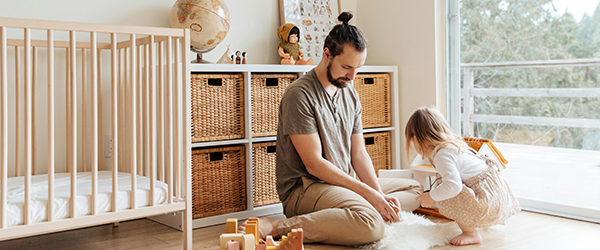Language development: The most important tips at a glance
4 minute readThere’s nothing quite like that first smile, the joyful babble, and then… the magic of their first word! A child’s language development is an incredible journey, and you play a starring role.
Our picture dictionary, “My 100 Words,” is designed to make learning vocabulary fun and engaging. Created with the guidance of Dr. Stephanie Wermelinger, a developmental psychologist from the University of Zurich, it’s the perfect tool to nurture your child’s growing language skills.
Want to know more about some of the best ways you can support your child’s language development? Here are some expert tips:

Tips for promoting language development in children
1. Follow the child’s attention
Forget flashcards and drills! The best way to boost your child’s vocabulary is by letting them be the teacher. Children learn particularly well when parents and caregivers focus on the child and don’t try to direct their attention elsewhere. So let the child take the lead. Look where the child is looking, name what they see and expand their vocabulary – it’s a simple yet powerful way to nurture your child’s love for language![2]
2. Speak slowly and clearly
Imagine you’re learning a new language – in these instances we all appreciate it if someone speaks slowly and clearly. Adapt your way of speaking to the child’s needs. Speak slowly, clearly and in simple language.[3] Simple language isn’t about ‘dumbing it down.’ It’s about giving your child the building blocks they need to understand more complex words and ideas later on. Speaking this way helps your child connect sounds to meanings, making it easier for them to learn new words and communicate with you.
3. Be patient, listen and ask open questions
Offer your child the opportunity to speak and don’t try to help them find words. Be patient, wait and just listen – even if they falter when speaking. If you do the talking for the child, they could easily become discouraged. Also, ask open questions to avoid yes or no answers. This is because a dialogue is important here: the child learns to speak best by speaking[4].
4. Comment on what you’re doing as you’re doing it
Children learn language through experience.[5] The words they learn fastest are the ones heard most often in their everyday life. Turn chores into language lessons! You can comment on your own actions or think aloud. The child listens to you and can thus expand their vocabulary in a very simple way, for example when shopping or cooking together.

5. Focus on the positives rather than correcting their mistakes
If the child makes a mistake, do not try to correct it. This could only discourage them.[6] It would be much better if you encourage the child to speak and, if necessary, pronounce the word correctly again. For example, if the child asks “cah?”, you can simply correct it by saying: “Yes, that’s a cat”.
6. Rhyme and sing together
Toddlers have a very special preference for nursery rhymes and songs because they have a particularly clear rhythm. With the help of the melody and rhythm, they can easily memorize long rhymes (and therefore new words!). Finger rhymes are particularly suitable here: they are usually funny and require accompanying gestures. At first, toddlers may not be interested in the content of the rhymes. However, this changes in due course and they also begin to understand the content better[7].
7. Read books together
Reading aloud and discussing picture books has a particularly supportive effect on the child’s language development.[8] Everything that’s being looked at should be talked about at the same time.[9] Reading and looking at books together can serve to expand the child’s vocabulary – because the child can point to what they see, comment on it or make the connection between what they hear and what they see more easily.
You can find more exciting information on language development in children in this blog article.

Our colorful picture dictionary
With our personalized dictionary, “My 100 words”, we celebrate the colorful world of words! Children can explore different animals, objects and colors through scenes from each season in a fun, enjoyable way.
The colorful illustrations help them to remember individual words faster and better – because even small children can intuitively decode and absorb pictures. So if pictures are linked with new words, they form a unit for the child that they can process and memorize even more quickly[9]. A wonderful book to optimally support your child’s language development
Sources:
[1] vgl. Sachse et al. 2020: 56; vgl. auch Dittmann/Buschmann 2022: 171
[2] vgl. Largo 2007: 373.
[3] vgl. Dittmann/Buschmann 2022: 171.
[4] vgl. Largo 2007: 373
[5]vgl. Largo 2007: 393.
[6] vgl. Largo 2007: 373
[7] vgl. Hoff 2015: 494.
[8] vgl. Largo 2007: 388
[9] vgl. Strauber 2020: 6; vgl. auch Van der Bijl 2006: 44.
Dittmann, F. und Buschmann, A.: Sprachförderung: Mit Kindern Bücher anschauen. Tipps und Tricks für Eltern von ein- bis dreijährigen Kindern. In: Sprache – Stimme – Gehör 47 (2022): 171-172.
Hoff, E.: Language development in bilingual children. In: E. L. Bavin and L, R. Naigles (Hrsg.): The Cambridge Handbook of Child Language. Cambridge Handbooks in Language and Linguistics. Cambridge (2015): 483-503.
Largo, R. H: Babyjahre. Entwicklung und Erziehung in den ersten vier Jahren. München (2007).
Sachse, S. et al.: Sprachentwicklung. Entwicklung – Diagnostik – Förderung im Kleinkind- und Vorschulalter. Berlin (2020).
Strauber, B. C. et. al: Using a picture-embedded method to support acquisition of sight word. In: Journal of the European Association for Research on Learning and Instruction 65 (2020): 1-8.





